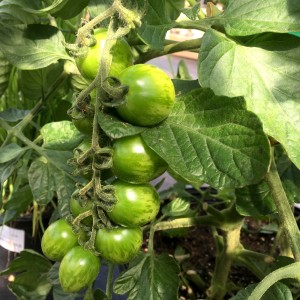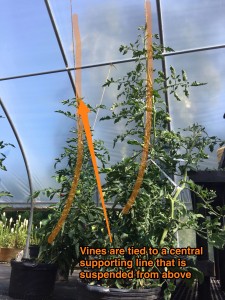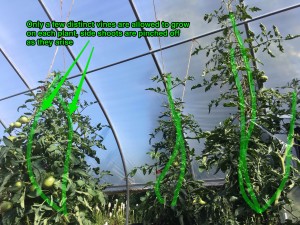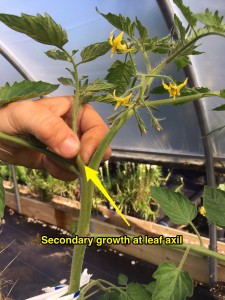 I hate growing tomatoes. They seem to get every problem that plants can get: early blight, late light, anthracnose, grey mold, damping off, powdery mildew, nutrient deficiencies, tomato horn worms, aphids, nematodes, spider mites … the list seems endless. That being said, every year we have a few tomatoes left over at the nursery that find their way into large pots for staff enjoyment. They are most often neglected and the harvest is minimal if any. But once again, I’ve gone for it. We have some ‘Green Zebra’, ‘Sungold’, ‘Cherokee Purple’, ‘Chocolate Sprinkles’ and ‘Lemon Boy’. I’m determined to have a bumper crop this year!
I hate growing tomatoes. They seem to get every problem that plants can get: early blight, late light, anthracnose, grey mold, damping off, powdery mildew, nutrient deficiencies, tomato horn worms, aphids, nematodes, spider mites … the list seems endless. That being said, every year we have a few tomatoes left over at the nursery that find their way into large pots for staff enjoyment. They are most often neglected and the harvest is minimal if any. But once again, I’ve gone for it. We have some ‘Green Zebra’, ‘Sungold’, ‘Cherokee Purple’, ‘Chocolate Sprinkles’ and ‘Lemon Boy’. I’m determined to have a bumper crop this year!
 I am by no means an expert on tomato culture, but I have done a lot of reading over the years. I’m still a little stymied when it comes to the perfect nutrition for these plants, but when it comes to training, I think I have it down. We’re lucky to have a greenhouse at the nursery. Growing these veggies under a roof seems to be making a big difference already. Here is my set up: I tied a thick length of twine to one of the purlins (supporting pipes) that runs down the length of the greenhouse and allowed it to dangle down to the plants in each pot. Next I tied each plant to the twine, with a loose figure eight knot using some flexible tape. I planted two tomatoes in each plastic nursery pot, super deep. Then I filled them up with nursery growing mix and some slow release fertilizer to get them going.
I am by no means an expert on tomato culture, but I have done a lot of reading over the years. I’m still a little stymied when it comes to the perfect nutrition for these plants, but when it comes to training, I think I have it down. We’re lucky to have a greenhouse at the nursery. Growing these veggies under a roof seems to be making a big difference already. Here is my set up: I tied a thick length of twine to one of the purlins (supporting pipes) that runs down the length of the greenhouse and allowed it to dangle down to the plants in each pot. Next I tied each plant to the twine, with a loose figure eight knot using some flexible tape. I planted two tomatoes in each plastic nursery pot, super deep. Then I filled them up with nursery growing mix and some slow release fertilizer to get them going.
 If left to their own devices, these plants would sprawl on the ground, forming a tangled heap with smaller, lesser-quality fruit. Judicious training and pruning should encourage fewer, but higher-quality, tomatoes that are held close to the support and easy to pick. Proper pruning also maximizes air flow and sun exposure as well, hopefully reducing fungal infections.
If left to their own devices, these plants would sprawl on the ground, forming a tangled heap with smaller, lesser-quality fruit. Judicious training and pruning should encourage fewer, but higher-quality, tomatoes that are held close to the support and easy to pick. Proper pruning also maximizes air flow and sun exposure as well, hopefully reducing fungal infections.
 As the plants grow, I select two leaders and continue to tie them loosely to the twine support as they grow. I prune away any other shoots. I have continued to prune the vines every week. Most of the growth is at the tip of each leader, but there are also many side shoots that emerge from the leaf axils along the vine. I pay close attention to those shoots and pinch them off when they are a few inches long. If I miss a few, and their diameter increases, I use my pruners so that I don’t damage the vine trying to tug them loose.
As the plants grow, I select two leaders and continue to tie them loosely to the twine support as they grow. I prune away any other shoots. I have continued to prune the vines every week. Most of the growth is at the tip of each leader, but there are also many side shoots that emerge from the leaf axils along the vine. I pay close attention to those shoots and pinch them off when they are a few inches long. If I miss a few, and their diameter increases, I use my pruners so that I don’t damage the vine trying to tug them loose.
